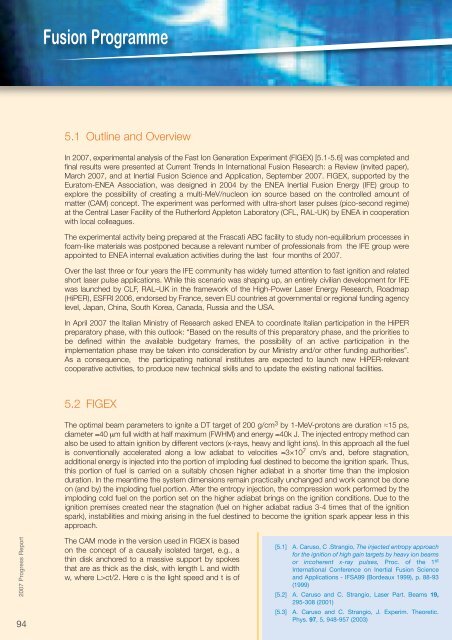Fusion Programme - ENEA - Fusione
Fusion Programme - ENEA - Fusione
Fusion Programme - ENEA - Fusione
- No tags were found...
You also want an ePaper? Increase the reach of your titles
YUMPU automatically turns print PDFs into web optimized ePapers that Google loves.
<strong>Fusion</strong> <strong>Programme</strong>5.1 Outline and OverviewIn 2007, experimental analysis of the Fast Ion Generation Experiment (FIGEX) [5.1-5.6] was completed andfinal results were presented at Current Trends In International <strong>Fusion</strong> Research: a Review (invited paper),March 2007, and at Inertial <strong>Fusion</strong> Science and Application, September 2007. FIGEX, supported by theEuratom-<strong>ENEA</strong> Association, was designed in 2004 by the <strong>ENEA</strong> Inertial <strong>Fusion</strong> Energy (IFE) group toexplore the possibility of creating a multi-MeV/nucleon ion source based on the controlled amount ofmatter (CAM) concept. The experiment was performed with ultra-short laser pulses (pico-second regime)at the Central Laser Facility of the Rutherford Appleton Laboratory (CFL, RAL-UK) by <strong>ENEA</strong> in cooperationwith local colleagues.The experimental activity being prepared at the Frascati ABC facility to study non-equilibrium processes infoam-like materials was postponed because a relevant number of professionals from the IFE group wereappointed to <strong>ENEA</strong> internal evaluation activities during the last four months of 2007.Over the last three or four years the IFE community has widely turned attention to fast ignition and relatedshort laser pulse applications. While this scenario was shaping up, an entirely civilian development for IFEwas launched by CLF, RAL–UK in the framework of the High-Power Laser Energy Research, Roadmap(HiPER), ESFRI 2006, endorsed by France, seven EU countries at governmental or regional funding agencylevel, Japan, China, South Korea, Canada, Russia and the USA.In April 2007 the Italian Ministry of Research asked <strong>ENEA</strong> to coordinate Italian participation in the HiPERpreparatory phase, with this outlook: “Based on the results of this preparatory phase, and the priorities tobe defined within the available budgetary frames, the possibility of an active participation in theimplementation phase may be taken into consideration by our Ministry and/or other funding authorities”.As a consequence, the participating national institutes are expected to launch new HiPER-relevantcooperative activities, to produce new technical skills and to update the existing national facilities.5.2 FIGEXThe optimal beam parameters to ignite a DT target of 200 g/cm 3 by 1-MeV-protons are duration ≈15 ps,diameter ≈40 μm full width at half maximum (FWHM) and energy ≈40k J. The injected entropy method canalso be used to attain ignition by different vectors (x-rays, heavy and light ions). In this approach all the fuelis conventionally accelerated along a low adiabat to velocities ≈3×10 7 cm/s and, before stagnation,additional energy is injected into the portion of imploding fuel destined to become the ignition spark. Thus,this portion of fuel is carried on a suitably chosen higher adiabat in a shorter time than the implosionduration. In the meantime the system dimensions remain practically unchanged and work cannot be doneon (and by) the imploding fuel portion. After the entropy injection, the compression work performed by theimploding cold fuel on the portion set on the higher adiabat brings on the ignition conditions. Due to theignition premises created near the stagnation (fuel on higher adiabat radius 3-4 times that of the ignitionspark), instabilities and mixing arising in the fuel destined to become the ignition spark appear less in thisapproach.2007 Progress Report94The CAM mode in the version used in FIGEX is basedon the concept of a causally isolated target, e.g., athin disk anchored to a massive support by spokesthat are as thick as the disk, with length L and widthw, where L>ct/2. Here c is the light speed and t is of[5.1] A. Caruso, C .Strangio, The injected entropy approachfor the ignition of high gain targets by heavy ion beamsor incoherent x-ray pulses, Proc. of the 1 stInternational Conference on Inertial <strong>Fusion</strong> Scienceand Applications - IFSA99 (Bordeaux 1999), p. 88-93(1999)[5.2] A. Caruso and C. Strangio, Laser Part. Beams 19,295-308 (2001)[5.3] A. Caruso and C. Strangio, J. Experim. Theoretic.Phys. 97, 5, 948-957 (2003)













